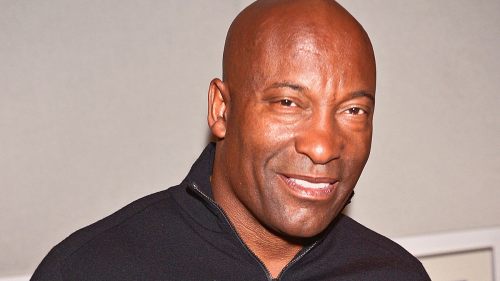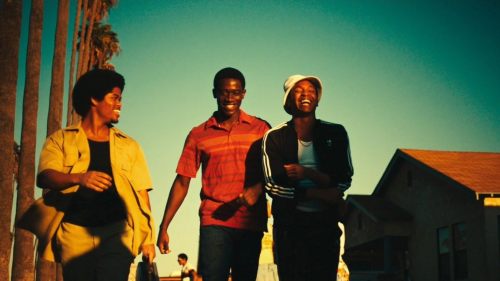ROSEWOOD: Deep South Into The Heart of Darkness
Whereas many Westerns have propagated the myth of the Old West as an era of high adventure and legendary figures, other films bring to life the harsh realities and savagery inherent in the push for western expansion and frontier living. Tales of Cowboys & Indians often downplay the great tragedy wrought upon the Native American people. But there is another tale of tragedy throughout American History suited to the Western that is virtually nonexistent in fiction and almost completely erased from real life records: the systematic destruction of African American communities and the razing of all-black towns. Directed by John Singleton of Boyz N' The Hood fame, 1997's Rosewood used the conventions of historical biographical films and Western tropes to tell the story of one such small town, resulting in a powerful statement on racial violence and one of only a handful of examples of a veritable Black Western.
Rosewood is a fictionalization of the events that took place in a Northern Florida town over several days during New Year's 1923. Rosewood was a prosperous African American community of approximately 300 townsfolk, which neighbored the white town of Sumner, home to the saw mill that residents of both communities worked in. As the film opens, we see a tenuous peace that exists between the two communities, or at least the closest thing one can call "peace" in an atmosphere of systematic subjugation where the threat of racial violence looms constantly over everything. This peace would soon be shattered when Fannie Taylor, a white woman, gets beaten by her illicit lover John Bradley and blames it on a made-up black man. A black convict named Jessie Hunter was known to have recently escaped from a nearby prison chain gang. Believing this escaped man to be the assailant, Sheriff Robert Walker, played by Michael Rooker, organizes a group of men to find him - a search party in name, but for all intents and purposes a witch hunt looking to burn a black man for the unthinkable crime of raping a white woman.
The search leads them to Rosewood, where the white perpetrator Bradley had sought help from the blacksmith Sam Carter, a black man and fellow Freemason. The search party torture and eventually kill Carter, but their blood lust would not be so easily satiated. The growing white mob continued their search onto the next day. One of the figureheads of the Rosewood community was Sylvester Carrier, played by Don Cheadle, who saw what was coming and took up arms for the inevitable confrontation. The mob arrive at his house demanding information about Jessie Hunter, but things quickly escalate and a firefight breaks out. Sylvester's mother, played by Esther Rolle, is killed, and Sylvester retaliates by killing two men who attempt to break into the house. The other women and children hidden in the house manage to escape into the swamps, but the fate of Rosewood has now been sealed. Word spreads about a “negro revolt” near Sumner, and hundreds of armed whites from neighboring counties and even other states arrive and form a rampaging lynch mob, who would eventually burn Rosewood to the ground and savagely murder every black citizen they encounter.
In any movie based on historical events, certain liberties are taken for the sake of dramatic license. One of the biggest liberties taken in this case comes in the form of the character Mann, played by Ving Rhames, a completely fictional personality modeled after the reluctant drifter Western archetype. Although he is not a real person, the characteristics of Sylvester and Mann are representative of a distinct black cultural shift during this time frame that is important in the understanding of these violent events. After WWI, many African-Americans were emboldened by their valiant service to their country and expanded horizons after seeing other parts of the world. They were no longer willing to accept their subservient roles as second class citizens, and there were movements in black communities all over the country demanding civil rights earned through a hard fought war abroad. There was great backlash against this by white communities and ethnic/low income whites in particular who faced increasing competition with the returning veterans for jobs. There were a number of bloody race riots after the war and through the 1920's, though unlike previous generations, the black communities with veterans forged in the fires of the great war were armed and willing to fight back against the mobs.
Concurrently, there was a growing establishment of the black cultural identity in American society as a whole, as the fashion and music of African-American culture helped to define The Roaring '20s. The most prominent example of this cultural significance was the Harlem Renaissance, though other black communities in cities like Chicago would cultivate great poets, writers, and artists that would serve to galvanize the greater cultural movement and push for civil rights. In Rosewood, Sylvester and Mann are representative of these two facets of African-American identity that came to be known as “The New Negro”, expressive and assertive, willing to fight back against white society with words and weapons if necessary, to stake their rightful claim as citizens of the greatest nation on earth. The combination of resistance against this black cultural encroachment, income disparity, and psycho-sexual fear mongering were all factors in the razing of Rosewood and many prosperous black communities like it.
When telling stories concerning oppression of minorities, audiences become weary of certain devices which may dilute the impact of the message. One of these objectionable devices is the dreaded “white savior”. There are several white characters who play a key role in the story of Rosewood, and while on the surface they seem like narrative inventions, their story is very much in line with the truth of what unfolded during those dark days. Jon Voight stars as John Wright, a merchant who owns the general store in Rosewood and lives with his family as the only white residents of the black town. Wright is given the most complexity throughout the film: he is an adulterous drunkard mainly concerned with filling his pockets, yet he is sympathetic to the people of Rosewood and tries to help during the increasing violence. Though initially ineffectual, he eventually hides some people from the lynchings and becomes instrumental in orchestrating the escape of the remaining townspeople. Of note, the climax of the movie involves Wright convincing two white train conductors to drive their engine by the town one last time in order to pick up survivors trying of the carnage. While this seems like an action movie set-piece construction, The history of the events reveal that brothers John and William Bryce did in fact use their steam engine to pick up stragglers along the route, although it is said that they would only pick up women and children, fearing reprisals from the white mob if they saw them aiding any black men trying to escape.
Wright and Mann begin with a contemptuous relationship as Mann seeks to buy a piece of land that Wright has his eyes on. They eventually gain mutual respect for each other built on their shared experience as military veterans. This nuance of character compared to the mostly villainous residents of Sumner and the mostly noble residents of Rosewood might make it seem like Wright is the central figure of the story. Even so, it is to Jon Voight's credit that he brings his full talents to the role, making good use of his on screen presence and recognizable star status to give weight to this tragic story and effectively establish the real life significance of the person he is portraying.
Like many of the lynchings and destroyed towns throughout this period, the story of Rosewood was covered up. This secret shame wasn't just covered up by the local residents under a code of silence; it was literally stricken from official records for decades. The official death toll of the incident was listed as two whites and six blacks, though a number of the black lives taken were listed as “deaths by unknown cause”. Fortunately, the truth of the massacre would eventually come to light, although it would take seventy years after the fact. Spurred by the digging of a Florida journalist and the key efforts by Arnett Doctor, one of the descendants of the Rosewood residents, the story eventually regained national attention and legal action was initiated. In 1993, a lawsuit was filed on behalf of the remaining survivors against the state government for its failure to protect them and their families. In 1994, the state senate finally passed a bill granting reparations to the remaining survivors, a landmark decision and one of only a handful of times in United States history where victims of racial violence would receive reparations. Later, a scholarship fund was created for descendants of Rosewood, and the area itself was established as a state historical landmark in 2004.
Watching the film again today, it is eerie how certain elements remain just as relevant as they did in 1923, during the film's premiere in 1997, and right now in 2016. As it directly relates to current movies, I was oddly reminded of elements in the Quentin Tarantino's recent racial violence western The Hateful Eight. People have argued that even though Tarantino's use of the N-word seems overly exploitative, its abundance is in line with the time period. As it turns out, I'm fairly certain “nigger” is used far more in Rosewood than in Hateful Eight, yet its use seems much more “organic” and suited to the story. I suppose there is something to be said for maintaining a serious tone when dealing with such serious issues, though maybe there is also an argument to be made based on the comparison between Singleton and Tarantino that maybe white people need to just chill the fuck out with the use of that word. I'll leave that argument for others to gnash their teeth over. It was also strange to see a little bit of that alleged Hateful Eight misogyny at play in Rosewood's epilogue, when Fannie Taylor, the instigator and author of all this pain, gets a (off-screen audio only) savage beating for all the trouble she has caused.
On a broader scale, failure of a corrupt legal system to protect all of its citizens equally is also relevant to the here and now. The Carrier family and the residents of Rosewood had every natural, written, and God-given right to defend themselves against armed terrorists and invaders on their land, but they couldn't possibly hoped to have fended of the entire white population of Florida. When we talk about institutionalized racism, its not just about police brutality or racial profiling, it is about the capitulation of the law to the status quo of white supremacy that has been at the core of our nation's legal system since its very inception. Making things truly fair and equal doesn't end at getting Stop and Frisk practices eliminated or people who murder blacks convicted, it's about the fundamental change on the part of the law enforcement and the court system to truly recognize African Americans and all minorities as Human beings and Citizens with inalienable rights that must be defended with the fervor and resolution afforded to the richest and whitest of our country. We must never forget the massacres of Rosewood, the Burning of Black Wall Street in Oklahoma, The Chicago Race Riots, and the scores of other racially motivated incidents of mass violence buried by their absence in history books and stories told on film. The Western genre of film is suited to tackling the darkest of themes and subject matter. As certain films dismantle the myth of the romantic old west by showing us the truth of Native American genocide, Rosewood remains a unique and shining example of telling the stories of our past that need to be told, lest their lessons be lost forever.



